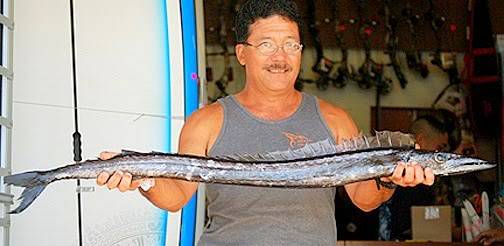
Gempylus serpens
FAMILY
Gempylidae
TAXONOMY
Gempylus serpens Cuvier, 1829, Tropic of Cancer.
OTHER COMMON NAMES
French: Escolier serpent; Spanish: Escolar de canal.
PHYSICAL CHARACTERISTICS
Maximum length approximately 40 in (1 m), commonly to 24
in (60 cm). Body greatly elongate and strongly compressed.
Tips of upper and lower jaws with cartilaginous processes.
Three immovable and zero to three movable fangs anteriorly
in upper jaw. First dorsal fin long with 26–32 spines, second
dorsal fin with 11–14 soft rays followed by five or six finlets.
Caudal fin well developed. Scales absent except on posterior
part of body.
DISTRIBUTION
Worldwide in tropical and subtropical seas; adults also caught
in temperate waters.
HABITAT
Strictly oceanic, epipelagic and mesopelagic from the surface to
depths of 656 ft (200 m).
BEHAVIOR
Usually solitary. Adults migrate to the surface at night; larvae
and juveniles stay near the surface only during the day.
FEEDING ECOLOGY AND DIET
Feed on fishes such as lanternfishes, flyingfishes, sauries, and
scombrids and on squids and crustaceans.
REPRODUCTIVE BIOLOGY
Males mature at approximately 17 in (43 cm) standard length,
females at 20 in (50 cm). Spawn in tropical waters throughout
the year. Fecundity is estimated at 300,000 to one million
eggs.
CONSERVATION STATUS
Not threatened.
SIGNIFICANCE TO HUMANS
There is no directed fishery for snake mackerel, but it sometimes
appears as bycatch in the tuna long-line fishery.
Other popular Animals
Photo Gallery of - Snake mackerel





 Animalia Life
Animalia Life